The Wonder of Jena
Wonderdome is a travelling planetarium.
A planetarium is a theatre designed to give educational and entertaining shows about astronomy.
But what is the history of the planetarium?
The German firm Carl Zeiss of Jena made the first planetarium projector.
Officially the Zeiss Model 1, it was know as the ‘Wonder of Jena’.
The Zeiss was an optical projector.
Powerful lamps inside the housing created the starlight.
It gave a realistic simulation of the night sky.
The projector was installed in the Deutsches Museum in Munich in 1923.
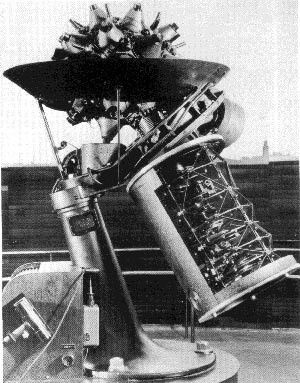
Carl Zeiss Mk 1 projector
Other companies like American Spitz and Japanese Goto joined the business.
Planetaria sprang up all over the world.
By 1930 Vienna, Rome and Moscow had planetaria.
Then planetaria spread to the USA.
In the 21st century, digital projectors entered the scene.
Now planetaria give shows with 360 degrees all-round video.
London Planetarium.
My blog tells the story of the first planetarium in the UK, the London Planetarium.
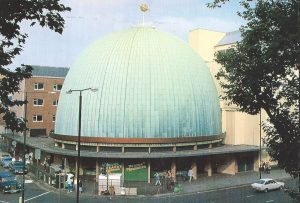
The London Planetarium. Credit: Madame Tussauds
The London Planetarium was opened by the Duke of Edinburgh in March, 1958.
It was owned and operated by Madame Tussauds and situated on Marylebone Road.
A splendid Pathe News film shows the interior of the dome.
Click the photo above to see the film.
It’s fascinating viewing.
The dome was a massive 18 metres across and housed an audience of 330 people.
A Carl Zeiss Mark IV projector gave a wonderful simulation of the night sky.

Zeiss Mark IV projector. Credit: Pathe News
When I visited the planetarium, narration came through the velvet tones of broadcaster John Ebdon.
In a later visit, the commentary was given by wonderful Heather Couper.
Later I became a friend of Heather.
She was guest of honour when I launched my own mobile planetarium, Stardome.
The building
I first visited London Planetarium in the 1970s, my first planetarium experience.
The experience was profound and set me on course to become a planetarium presenter.
Some of he images in this blog are taken from my souvenir programme and post card set.

Dennis’s programme from his first visit.
We walked into the theatre, which looked like a typical cinema.
Except that the ceiling wasn’t flat but dome shaped.
We sat down in comfortable cinema-style seats.
To our delight, we found that they reclined to an angle.
The lights slowly dimmed as John Ebdon’s dulcet tones took us through twilight.
Then the last vestige of light disappeared – and the stars came out!
It was nighttime in the middle of the day.
The show took us on a sky tour of constellations and prominent stars.
Mythological constellation images appeared to outline the star patterns.
And among the stars, the planets appeared.
All too soon for me, the morning twilight came and the stars were gone.
It was an entrancing show, a memorable experience.

London Planetarium opening, 1958. Credit: Pathe News
The dome.
The 18-metre dome seemed off-white in the subdued lighting.
It takes a few minutes for our eyes to adapt to the dark.
Around the lower edge of the dome, London was represented by silhouettes of prominent buildings.
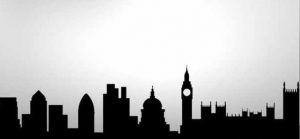
London skyline similar to planetarium border.
The Projector
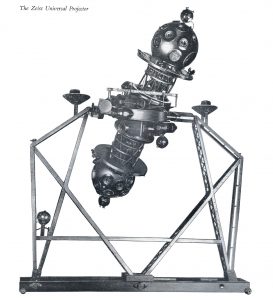
The Zeiss Universal projector. Credit: London Planetarium.
The Zeiss Mk IV at London Planetarium was 4.2 metres long.
A steel lattice supported the dumbbell assembly.
It looked like an alien two-headed monster from a distant world.

Projector close-up. Credit: Pathe News
The projector is designed to give an accurate simulation of the night sky.
Stars and planets appear on the dome in their correct positions and relative brightness.
The projector moves to simulate the rotation of Earth.
The assembly weighed in at 2 tons and contained 200 individual optical projectors.
A magical property was that the planetarium could show the night sky at any time, any date in any part of the world.
We could see the southern constellations from Australia whilst remaining in our comfy seats.
Star projection
In all, some 8,850 stars were shown with complete accuracy and realism.
The 42 brightest stars had individual lenses and showed colour.
So Aldebaran, Betelgeuse and Antares appeared distinctly red.
The remainder of the stars were produced by 32 photographic plates.
Each plate had its own lens and they were grouped around a 1000 watt lamp.
Together, they produced a starry sky on the whole surface of the dome.
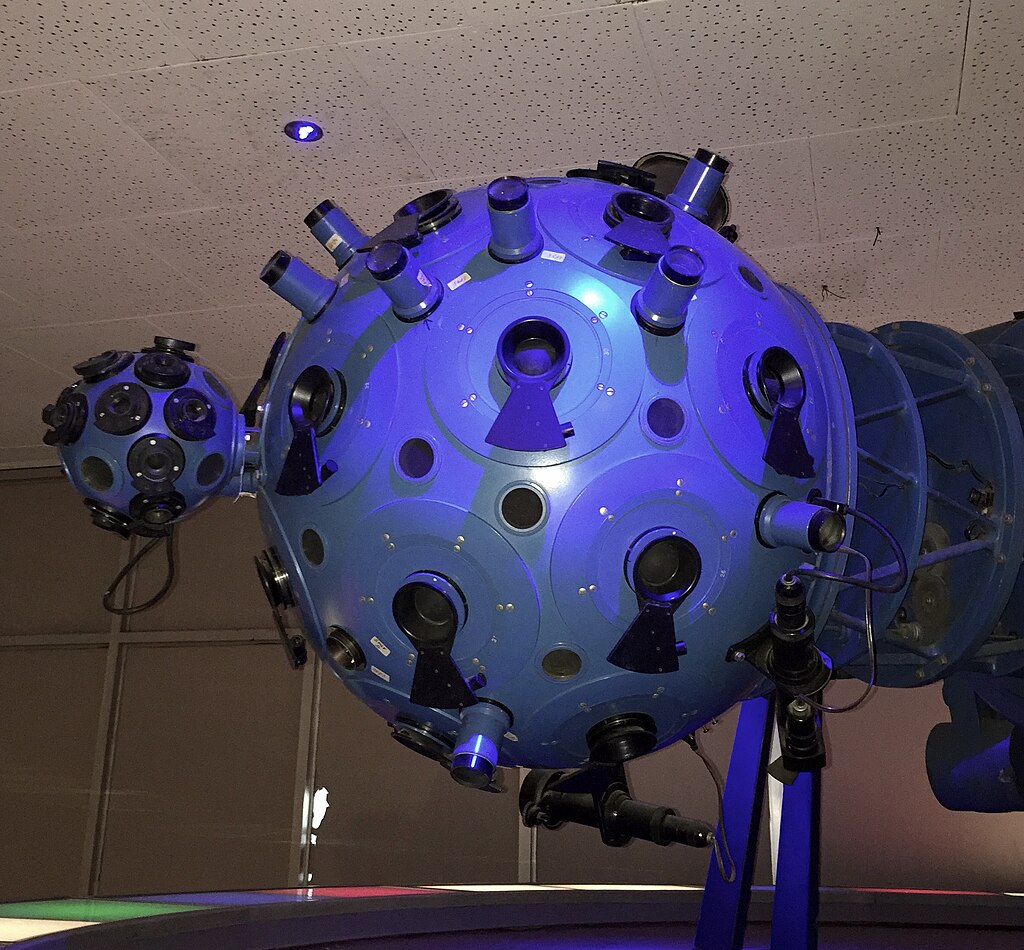
Lens bearing sphere of the Zeiss projector. Mumbai Planetarium.
The Milky Way was produced by photographic plates in a separate projector.
The projectors could even fade stars as they set over the horizon.
This was done by blinkers that gradually dimished the brightness.
Constellations
The planetarium could also show constellation shapes.
At the flick of a switch, lines of light appeared and joined stars together.
This made it easy for the audience to recognise the star patterns and place of significant stars in them.
Another switch projected constellation images to overlay the stars.

Orion & Lepus. Credit: Pathe News
Solar System
Each planet on view had its own projector.
They reproduced accurately the position, brightness and colour of each distant world.
Another projector made meteors, shooting stars, fizz across the night sky.
A great comet is a spectacular sight in the sky.
The London Planetarium showed the great comet Donatti as it appeared in 1858.
The Northern Lights is another sky highlight.
An ancillary projector produced shimmering curtains of coloured light.
The audience could experience arctic glory from the warmth of a comfortable seat.
Control Console
A control console ran the show.

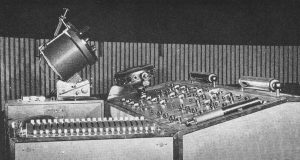
Control Console, London Planetarium.
A series of switches operated the motion of the spheres and individual projectors.
The shooting star and aurora projectors were also attached here.
Upgrades
In 1995, a Digistar II projector replaced the old Zeiss.
As it’s name suggests, it was an early digital system.
It cost £4.5 million. I didn’t like it!
The monochrome display showed the stars as green dots, not at all realistic like the old Zeiss.
Overlay effects were OK but the overall impression was of an artificial sky.
In 2004 a further upgrade saw the installation of a Digistar III system.
This was much better. It showed 360 degree colour video.
The shows moved from simple night sky to voyages through the Solar System and beyond.
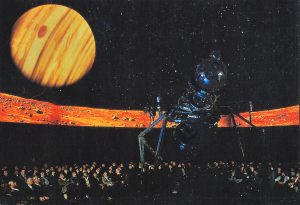
London Planetarium interior, around 2004.
Shut Down
Sadly the new digital era didn’t last for long.
Education Officer Teresa Grafton retired in 2006.
Almost immediately, the Madame Tussauds management closed the planetarium.
Saddened and angry, Teresa said in an interview:
“I hugely regret that the big green dome will open no more
– the London Planetarium is no more –
and no more children will share the excitement and feel the magic of getting to know our universe.’
The crass decision also angered the astronomy community.
Astronomer Robin Scagell commented:
“The Planetarium always made money for Tussauds when it featured real astronomy shows.
“I’m amazed that the Tussauds management can’t come up with exciting and interesting shows about the wonders of the universe that will attract audiences again.
They have a valuable resource that they are squandering through a lack of imagination.”
The planetarium became a kind of ‘Celebritarium’.
It gave shows featuring film and TV celebrities.
The ‘Marvel Universe 4D Experience’ now occupies the dome..
That is a universe I have no interest in and will never visit.
London Planetarium at Greenwich
Peter Harrison Planetarium, Greenwich. Photo: Royal Museums Greenwich
The good news is that London still has a planetarium.
It is the Peter Harrison Planetarium at Greenwich.
In the past I visited the old Greenwich Planetarium.
So far I have not been to the Peter Harrison.
Greenwich is one of my favourite places.
The new London planetarium is on my bucket list.
The Zeiss and me
For a couple of years, I worked at Yorkshire Planetarium in the grounds of Harewood House.
There I used the magical Zeiss ZKP4 projector.
It is a more compact version than the Madame Tussauds model but more sophisticated.
A PC controlled the shows, which moved on at the touch of a button.
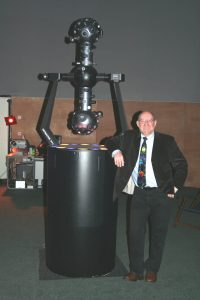
Dennis with the Zeiss ZKP4 projector.
The planetarium had a 12-metre dome which could seat an audience of around 150.
The starfield was a perfect night sky, the best planetarium sky I have ever seen.
One day I took binoculars and found star clusters which the naked eye couldn’t see.
It was magical!
Sadly, after a couple of years Yorkshire Planetarium closed its doors.
I believe that the wonderful Zeiss is in Bradford, waiting for a new home.
Wonderdome
If you are a teacher or event organiser interested in a planetarium visit, look no further.
Wonderdome travelling planetarium can bring the universe to you!
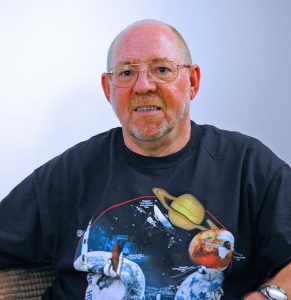
The author: Dennis Ashton is a Fellow of the Royal Astronomical Society and a Wonderdome presenter.
Would you like to hear more Astronomy news?
Do you want to to find out about our upcoming public events?
Follow WonderDome Portable Planetarium on Twitter and Facebook or go to our web site wonderdome.co.uk


